|
The
 News
News
Dedicated to Austrian-Hungarian Burgenland Family History |
THE BURGENLAND BUNCH NEWS - No. 288
June 30, 2018, © 2018 by The Burgenland Bunch
All rights reserved. Permission to copy excerpts granted if credit is provided.
Editor: Thomas Steichen (email:
tj.steichen@comcast.net)
BB Home Page: the-burgenland-bunch.org
BB Newsletter Archives: BB Newsletter
BB Facebook Page:
TheBurgenlandBunchOFFICIAL
Our 22nd year. The Burgenland Bunch Newsletter is issued monthly online. It was founded
by Gerald Berghold (who retired from the BB in the Summer of 2008 and died in August 2008).
|
Current Status Of The BB:
* Members: 2650 * Surname Entries: 8371 * Query Board Entries: 5732 * Staff Members: 15
|
This newsletter concerns:
1) THE PRESIDENT'S CORNER
2) FINDING THAT UNKNOWN / MISSPELLED VILLAGE – TAKE TWO
3) FAMILYSEARCH’S RECORD-PRESERVATION STRATEGY
4) MORE DATA FROM THE HISTORISCHES ORTSLEXIKON
5) HISTORICAL BB NEWSLETTER ARTICLES:
- WAS MEINT "HEIMAT"? HOW IS "HEIMAT" DEFINED?
6) ETHNIC EVENTS
7) BURGENLAND EMIGRANT OBITUARIES (courtesy of Bob Strauch)
|
1) THE PRESIDENT'S CORNER (by Tom Steichen)
 In
this month's collection of bits and pieces in Article 1 are tidbits
on the negative effects of the new GDPR, on Latin genealogical words, on romance
DNA-style, on spam-fighting overkill, on the latest St. Louis gathering and on a
Burgenland survey, plus a few others. In
this month's collection of bits and pieces in Article 1 are tidbits
on the negative effects of the new GDPR, on Latin genealogical words, on romance
DNA-style, on spam-fighting overkill, on the latest St. Louis gathering and on a
Burgenland survey, plus a few others.
Article 2 is Take Two on Finding that Unknown / Misspelled
Village. I wrote about this topic last month but now give you a different twist on the
problem. Unfortunately there are no nifty tricks this month, just hard work based on long
experience!
Article 3, talks about FamilySearch’s Record-Preservation Strategy.
Hopefully, it will explain why the records you most want to see online may not be the
ones that FamilySearch chooses to make available.
Article 4 reports More Data from the Historisches Ortslexikon, a
publication that documents the historical settlement history and population counts for the
states, counties, districts and villages of Austria. This time, I'm looking at some of the
overall population data for Burgenland since 1570, and also the "ethnic" subpopulation data for
Croatians, Hungarians, Romany, and Jews. The patterns of change in these data is informative.
The remaining articles are our standard sections: Historical Newsletter
Articles, and the Ethnic Events and Emigrant Obituaries sections.

GDPR Effects: I mentioned last month that the EU's General Data Protection
Regulation (GDPR) took effect. It regulates how companies must manage personal data of
residents of the European Union; failure to comply would subject them to significant fines.
Not surprisingly, some companies are going out of business rather than spending the money needed
to meet all aspects of the regulation. In the genealogy/DNA arena, three companies, World
Families Network, Ysearch, and Mitosearch, have chosen to go out of business
rather than comply.
World Families Network was a website created to help with Surname Projects at
FamilyTreeDNA. Ysearch and Mitosearch were established in 2003 by
FamilyTreeDNA to allow people to compare results for YDNA or mtDNA from any testing company.
Since other companies have dropped these tests, making FamilyTreeDNA the only vendor,
these last two services largely lost their usefulness, thus were terminated.

 Latin
Phrase Dictionary: The Genealogy In Time magazine website has an online
translating dictionary for Latin words and phrases that might appear in wills, parish records or
land records. You can find it here: Latin
Phrase Dictionary: The Genealogy In Time magazine website has an online
translating dictionary for Latin words and phrases that might appear in wills, parish records or
land records. You can find it here:
genealogyintime.com/dictionaries/genealogy-latin-dictionary-pageA.html

 DNA
Romance: So, can DNA help you find that Mr. or Ms. Perfect? DNA
Romance: So, can DNA help you find that Mr. or Ms. Perfect?
Website DNA Romance, an "online platform for singles looking for genuine relationships
based on chemistry and personality compatibility," claims it is "bringing chemistry to
online dating using DNA matchmaking." It says they "provide evidence-based matchmaking,
saving our customers time, money and frustration by matching them with Mr Right or Ms Right
sooner."
They argue that chemical attraction is an essential ingredient for a romantic
relationship, and that in-person chemical attraction is detected by your nose (thus explaining
the expression that "love is in the air"). Further, that their platform uses specific DNA
markers to "forecast the level of chemical attraction between you and other members."
All you need to do is upload your DNA results (from any of the major testing companies), fill
out a personality questionnaire, then await your three free matches. After that, you can
"unlock and communicate [with] more matches for a small monthly fee."
If you can't resist, here is the website:
www.dnaromance.com.

Additional Digitized LDS Films: Three Burgenland-area microfilms were released for
access this past month. The three newly-released films are for the Hungarian border area that we
list (two for Körmend; one for Rábaszentmihály), reducing that missing count to 16. For
Burgenland-proper, 15 films remain undigitized. Our LDS pages (at
http://www.the-burgenland-bunch.org/LDS/LDS.htm) have been updated to document these
additional films and provide links to the images.
Of the 31 microfilms remaining to be converted, 7 are Lutheran, 11 are Catholic, 7 are Civil and
6 are Military. We will, of course, monitor these unconverted microfilms and add the digital
collection numbers and links when they become available.

Spam Overkill, Version II: Yes, it happened again... back in January, I reported
that a BB member had chosen to use the SpamArrest software, which requires email senders
to fill out a "sender verification" form, supposedly to validate that I was a legitimate email
sender before it would send my message on to my intended recipient. SpamArrest was clear
overkill because it also required that I accept its atrocious "Sender Agreement,"
something I simply could not do.
The latest occurrence (via the EarthLink spamBlocker software) is not nearly so bad, as
it just allows the recipient to "approve" email delivery—no dastardly
"sender agreement" wherein I promise my first born [or up to $2000] should the recipient
be offended by my message.
However, its use was still "bad form" because I was merely responding to a request for help from
this correspondent. I felt that the correspondent should have pre-approved me rather than
forcing me through the verification process (spamBlocker allows the user to do so merely
by adding the address to its address book). After all, the correspondent used my email address
to send a help request to me, so wanted a return email via it, which I was trying to do.
Despite not being happy about this (admittedly minor) inconvenience (and I told my
correspondent so), I chose to submit the form (see below) [note: I replaced part of the
correspondent's email address to make it anonymous]. Using the form was inoffensive,
as it merely popped up a screen that said my "request" had been passed on for approval.

Still, if you are asking for help from someone, you shouldn't make them jump through hoops to do
so. Spam is a fact of online life, of which I get a massive share given my wide web presence. I
deal with mine quietly... you should with yours too.

Trip Report, Southern Burgenland: Annette Kapple wrote to say she had
written a blog post about her recent visit to Güssing and Inzenhof. Annette's post is fairly
long but quite informative, and is complete with 100+ pictures, so give it a look if you can;
you can find here:
annettekapple.blogspot.com/a-visit-to-southern-burgenland.

May St. Louis Burgenländer Gathering: Several new friends joined our St. Louis
Burgenländer Gathering in May. There were over 40 in attendance. The afternoon was most
enjoyable, as we shared photos and stories about our ancestors and some great Austro-Hungarian
food! So many connections were discovered.
We now have a St. Louis Burgenländer Facebook page, the primary purpose being to connect
the descendants of Burgenländers who settled in St. Louis. We are planning a Fall Cemetery
Crawl and our next St. Louis Burgenländer Gathering will be November 11. If you live
near or are planning a trip to the St. Louis area, we would love to have you join us. Contact:
theresamcwilliams32@gmail.com.

Note: Theresa included a photo that was shared at the Gathering
by Donna Schnalzer Huneke that was inscribed with title "Anschluß Bund" (see below). I
looked for mention of such a group (whose title I translate as "connection alliance") but did
not find anything, so I assume it was a temporary combination of a number of St. Louis singing
groups (perhaps an "all star" group), likely assembled for a fund-raising concert. Theresa says
that her "best guess is that the Anschluß Bund photo was taken between 1914 -1917 in
St. Louis."
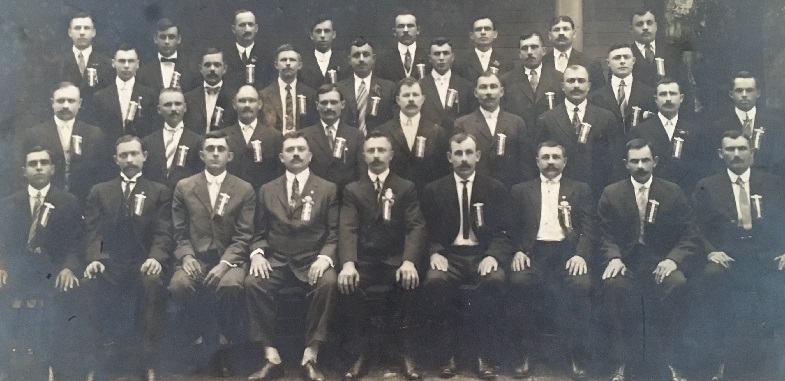
Photo inscribed "Anschluß Bund"
The Gathering attendees were able to name three of the participants:
- Ferdinand Schnalzer (second row, 5th from left) of Deutsch Schützen (1880-1952),
grandfather of Donna Huneke, the owner of the picture;
- Stefan Taschler (front row, 2nd from left) of Deutsch Schützen (1881-1928),
great-grandfather of Theresa McWilliams; and
- a Rossner, presumed to be Stephan (front row, 3rd from left) of
Deutsch Schützen (1889-1963).
We invite those of you with St. Louis roots to see if you recognize anyone; if so, please share
details with Theresa or me. You can find a higher-resolution image here:
photo (once open, click the image to
get a still-closer view). [I am also curious about the ribbons the group members are wearing,
especially why a few ribbons seem more elaborate; if you know anything about these ribbons,
please enlighten me!]

Satisfaction with Burgenland State Government: In a somewhat curiously
designed survey of 1000 Burgenländers (conducted both online and via telephone, but only
in districts Mattersburg, Eisenstadt-Umgebung and Neusiedl am See), the Burgenland government
reports that citizens are much more satisfied with the state government than with either the
Austrian federal government or the European Union.

The survey reports that 79 percent of Northern Burgenländers are very or rather
satisfied with the work of the Burgenland provincial government, whereas the Austrian
federal government gets only 56 percent approval and the European Union only 35 percent.
I find this to be a "curiously designed" study for a number of reasons, the first being the
obvious exclusion of middle and southern Burgenland! Given it was an online and telephone
survey, physical logistics can't be the reason for excluding them. So why? Are
they inherently less satisfied with government(s) and therefore to be avoided?
Second, the "round" 1000 number of surveyed citizens makes the statistician in me wonder about
the reliability of the study: how big is the sampling error?; was the number of respondents
chosen arbitrarily or did it meet a pre-determined criteria?; is this really a scientific study
or just political posturing?
Third, the results of the survey seem obvious... local governments should be much
more attuned to local issues and therefore should have opportunity to garner more
local approval. The fact that this survey is in line with that expectation is good (but
unsurprising) ...whereas, failure to attain greater local approval would have been highly
disturbing!
Perhaps an additional or more-informative approach would have been to present the approval
ratings relative to previous ratings or those in other Austrian states.

 Update
for book "The Burgenländer Emigration to America": Here is this month's update on
purchases of the English issue of the 3rd edition of Dr. Walter Dujmovits' book "Die
Amerika-Wanderung Der Burgenländer." Update
for book "The Burgenländer Emigration to America": Here is this month's update on
purchases of the English issue of the 3rd edition of Dr. Walter Dujmovits' book "Die
Amerika-Wanderung Der Burgenländer."
Current total sales are 1309 copies, as interested people purchased 9 more books during this
past month.
As always, the book remains available for online purchase at a list
price of $7.41 (which is the production charge for the book, as we purposely
choose not to make a profit so we can avoid dealing with the income tax consequences and
so you can obtain the book at as low a cost as possible!), plus tax & shipping. See the
BB homepage for a link to the information / ordering page and
for information about current discounts (there is at least one discount on price or shipping
available most of the time... if not, wait a few days and there will be one!).

Burgenland Recipes: This recipe is from ongoing contributor Christine Rubba.
SAUERKRAUT(from Christine Rubba)

Ingredients-Kraut:
1 can or jar of sauerkraut
(for example, Hengstenberg, one of the best Bavarian-style German brands, or Bicks,
which usually has wine in it)
Ingredients-Other:
1 piece of smoked ham (about 300 grams [2/3 lb.])
2 cup beef broth (Knorr beef cubes work well too)
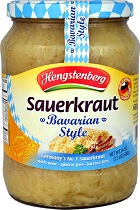 1
apple, cut into small pieces 1
apple, cut into small pieces
2 Tbsp. lard or vegetable oil
1 onion (optional), cut into small pieces
1 small potato (optional), grated
Preparation-Meat:
1) Boil the smoked ham separately for ½ hour.
2) Take a ½-inch slice and cut it into small pieces to use in the sauerkraut.
3) Keep the remaining ham warm; you will eat the finished sauerkraut with it.
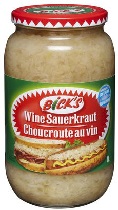
Preparation-Kraut:
1) If using boullion cubes, boil water and prepare broth according to directions.
2) Use both the kraut and the liquid from the container. If necessary, add up to ½ cup of water.
3) If you do not care for a lot of sour taste, then go ahead and rinse.
4) Boil the kraut and apple for 30 to 45 minutes, until soft.
5) Put lard or vegetable oil in a pan and heat, add the cut up onion and fry for 5 minutes or so
until soft.
6) Add the kraut, the cut up pieces of ham, and beef broth, and bring to a simmering boil.
7) You can thicken up the sauerkraut by adding the grated potato.
8) Boil for another 10 minutes.
9) Done. Guten Appetit!
Serving Suggestions:
Serve with the remaining smoked ham, smoked sausage or bratwurst.

 Reminder:
We no longer have a "regular" source for Burgenland recipes. As evidenced above, a few readers
have shared favorite family recipes, and we do have a reserve for a couple of months now, but if
contributions stop coming in, we'll be begging again! So, please consider sharing your favorite
Burgenland recipes or recipe books with us. Our older relatives sadly aren't with us forever, so
don't allow your allow your favorite ethnic dishes to become lost to future generations. Send
your suggestions to BB Recipes Editor,
Alan Varga. Thanks! Reminder:
We no longer have a "regular" source for Burgenland recipes. As evidenced above, a few readers
have shared favorite family recipes, and we do have a reserve for a couple of months now, but if
contributions stop coming in, we'll be begging again! So, please consider sharing your favorite
Burgenland recipes or recipe books with us. Our older relatives sadly aren't with us forever, so
don't allow your allow your favorite ethnic dishes to become lost to future generations. Send
your suggestions to BB Recipes Editor,
Alan Varga. Thanks!

Cartoon of the Month:

|
2) FINDING THAT UNKNOWN / MISSPELLED VILLAGE – TAKE TWO
Last month I ran an article with the above title... well, less the " – Take Two" part. I
decided to incorporate that title into this one because I have a qualitatively
similar, yet factually different, story to tell about another "head-scratcher" village. Let me
state the initial facts (the story gets more complicated later!):
In her registration form, BB New Member Carol Koziol included surnames Kalchbrenner
(from Goberling), Wehofer (unknown village), Schlaffer (Deutsch Schützen) and
Kalchbrenner (again, this time from Halyez), all settling in Chicago in various years
in the early decades of the 20th century.
It was, of course, that "Halyez" village name that caused the BB staff to start rubbing
our collective heads. Patrick Kovacs, in his welcome message to Carol, mentioned that “Halyez”
is not a Burgenland-area village—at least not by that spelling,
and Johnny Santana proposed “Halászi” as a potential corrected spelling, which is a
Hungarian village some 10 miles east of the Neusiedl district.
That prompted me to write to Carol, saying: Do you have a document that provided
your spelling? Also, can you provide some detail about the Kalchbrenners from there: given
names, birth dates, emigration dates, spouses/marriage dates, religion, etc. that might help us
confirm a particular village? If so, please send it to me and we’ll see if we can nail down the
proper spelling. We can also be more helpful with your other names/villages if you provide
similar information for them.
However, before Carol could reply, Johnny Santana sent a follow-up message with some
attached manifest pages, simply saying: Joseph Kalchbrenner arrived 12 Nov 1910 aboard
the Blucher out of Hamburg to Ellis Island, line 24.


I show the Ellis Island "passenger search" index text and a clip from the first of a
two-page manifest above and a clip of the corresponding lines from the second page below.

After looking carefully at the above information, I replied:
Well that seems to be the source for the reference to place "Halyez" ...but it
applies to the NEXT name on the manifest, NOT to Joseph Kalchbrenner (despite what the index
claims!).
Joseph is listed as last living in Rabenhorst, Germany (which is way in the north of
Germany) and he is part of the Franz Frühwirth family listed above him (he is marked as a
nephew). I read his birth place as Fabnitz, Hungary (same as the birth place of Josepha
Frühwirth, wife to Franz). My guess is that it probably should be Rabnitz (Unterrabnitz
is just 8 miles from Goberling). Frühwirth is, of course, a Burgenland name. Franz
Frühwirth is also listed as born in Hungary, but the village name is difficult to make out...
my best guess is "Kalosz" ...but I can find no village by that name.
So, though we solved the problem of this unknown "Burgenland" place, Halyez, we
introduced two more unknown, possibly-misspelled village names, Fabnitz and Kalosz.
 Knowing
that more eyes on a problem are always helpful, I wrote to the BB staff, asking them to look at
this manifest and to make suggestions on the village names, both on my transcriptions of the
writing and their interpretations of what the village names should be. Knowing
that more eyes on a problem are always helpful, I wrote to the BB staff, asking them to look at
this manifest and to make suggestions on the village names, both on my transcriptions of the
writing and their interpretations of what the village names should be.
For the benefit of you, my readers, I include a larger clip of the birth-village names to the
right. The top one is what I read as Kalosz, and the second and fifth are what I read as
Fabnitz. The third and fourth are Wien and Rabenhorst (birth places of the
two Frühwirth children), and the last is that now-irrelevant Halyez.
Shortly after I sent my request-for-help message to the staff, I took a second look at
those village names, which prompted me to send yet another message:
A follow-up thought... the birth place may be a scribbled, phonetic Jabing (i.e.,
Jabink)... and there was a Joseph Kalchbrenner born there in 1910. Still have no idea for "Kalosz"
though.
This prompted Bob Strauch, who always has a good eye for these difficult handwriting
samples, to reply:
Tom et al., I think you're right about Jabink / Jabing. The uncle in
Chicago was Josef Farkas, and we have a Joseph Farkas, 1867-1923, on BH&R-IL
[Burgenländers Honored and Remembered, Illinois section] and he was from Jabing.
I read "Halyez" as "Halycz", which probably refers to the city of Halych
in the western Ukraine, which gave its name to the historic province of Galicia.
All of the above prompted Carol to write, saying (in part):
Sorry about all the confusion. When I looked at the Ellis Island info (about 3 years
ago), I obviously skipped down a line when looking at place of birth. My grandfather was born in
1889-1890; he died in 1970. His father was Johann Kalchbrenner. My grandfather married Anna
Kalchbrenner in Chicago… yes, same last name; they were second cousins. She was born in
Goberling in 1893. They were Lutherans. I’m not familiar with the Frühwirth name.
Her message prompted me to do a little research (which took a curious twist) and led to
this reply (in part) by me:
Hi Carol, that manifest is hard to sort out, as the writing drifts downward making it hard
to tell what is part of the same line. It even fooled whomever indexed the record, as they
listed Halyez for your guy too.
It does seem clear, though, that the birthdate used in the US (4 Apr 1890) is off a few
days... the correct date appears to be 9 Apr 1890 and the birth was in Jabing. I have attached
Joseph's birth record... well, more accurately, records! This birth is recorded in both
the Catholic (first attached image, see line 8) and Lutheran (second attached image, see line
9) records because the father was Lutheran and the mother Catholic. I have also attached the
marriage record for his parents (third image, line 3) [images not included here]. They
married only a few months before the birth, which may explain why a mixed-religion marriage
was allowed. The parent's ages and their parents' names are listed in the record, which should
help you track further back along the family lines. (That is the Catholic record... I assume
the marriage is recorded in the Lutheran records too.) Bu the way, János is the
Hungarian form of Johann, so don't be thrown by the name switch in the records.
So, it looks like we need to drop this Halyez village and substitute Jabing for
Joseph... and, of course, maintain Goberling as the village for Josef's wife, Anna
Kalchbrenner.
The "curious twist" was, of course, that the birth record appears in both the Lutheran
and Catholic records. I had never seen that before (though I can't say I have ever looked
for that type of thing before!). The reason I discovered this dual recording was because
I looked in the Catholic records (by force of habit, I expect) and found it there before
I realized that Carol had said the family was Lutheran. Presuming I had found the wrong
birth, I went over to the Lutheran records and found it, essentially-identically
recorded, there also. That prompted me to study these records, which both indicated that the
father was Lutheran and the mother Catholic... even then, I hunted down (one version of) the
marriage record to confirm this mixed marriage.
We also heard again from Bob Strauch, who wrote:
Kalosz (birthplace of Franz Frühwirth) = Gálos (now Gols, Burgenland)
From the Hungarian Catholic Church Records:
Name: Franciscus Früwirth
Event: Type Baptism
Event Date: 07 May 1865
Event Place: Gálos, Moson, Hungary
Gender: Male
Father's Name: Josephus Früwirth
Mother's Name: Anna Ganitsch
Cook County Death Records:
Name: Frank Fruehwirth
Birth Date: 1865
Birth Place: Hungary
Death Date: 22 Jul 1914
Death Place: Chicago, Cook, Illinois
Burial Date: 24 Jul 1914
Cemetery Name: St Mary
Death Age: 48
Occupation: Barn Foreman
Race: White
Marital Status: Married
Gender: Male
Residence: Chicago, Cook, Illinois
Father Name: Joseph Fruehwirth
Father Birth Place: Hungary
Mother Birth Place: Hungary
FHL Film Number: 1287503

And that concludes Part One of this article, wherein we discovered that the
mystery village Halyez was irrelevant and the equally-confounding villages
Kalosz and Fabnitz were relevant, especially Fabnitz, which
turned out to be Jabink = Jabing.
I wish I could relate some nifty tricks that might help you sort out such misspelled
village names like these... but there are no big tricks, just hard work. Bob and I are able to
do so because we've spent 20 years looking at problems like these. We know what village names
are possible and we have developed a deep understanding of the phonetic and spelling variations
that typically occur. Thus we are able to develop reasonable hypotheses that we can test with
data.
In this case I asked myself: is Fabnitz really Jabink, which is a phonetic version
of Jabing? If so, could I find the birth of Joseph Kalchbrenner in those records
and thus prove myself correct? That was the approach I took and it proved correct.
Now, while I don't know for sure, I think I know the approach that Bob used to
prove that Kalosz = Gálos / Gols (and this is a little bit of
a "trick"). I think he started with the Franz Frühwirth name and a comment I made after
he mentioned that the uncle in Chicago that the family was joining was Josef Farkas from Jabing.
I said: "Yes, and the Franz Frühwirth that Josef Kalchbrenner traveled with died in 1914,
with his wife Josephine being informant." So, he looked for the death record, which
indicated that Franz Frühwirth was born in 1865 and his father was
Joseph. Now Bob jumped to the LDS index looking for a birth record for a Franz Frühwirth
born in 1865 with father Joseph, finding the one he listed above... it showed
Gálos as birth location, and then it was but a small jump to realize that Kalosz
was a phonetic version of Gálos. A nice bit of work!

Before going on to part two of this article, I want to complete a circle started
back with the ship manifest for Joseph Kalchbrenner. You may recall that Joseph traveled with
the Frühwirth family, was listed as a nephew, and was born in the same town as Josepha,
wife of Franz Frühwirth.
I wrote (in part) to Carol:
By the way Carol, it looks like the Josepha, wife of Franz Frühwirth, of the family
your Joseph traveled with, was born 8 Feb 1879, out of wedlock, to an Anna Kemeter
(Catholic).
I searched forward from that date and the first marriage record I found for an Anna Kemeter
was the one who married János Kalchbrenner (the marriage record I previously shared
[for the parents of Joseph Kalchbrenner]), implying that Josepha and
Joseph were at least half-siblings (and likely full siblings). Although Joseph was listed
as a nephew on the passenger manifest, his correct title likely should have been
brother-in-law (to Franz).
The possibility exists, though, that there were more than one Anna Kemeter in
town and that the one who birthed Josepha never married (and therefore isn't Joseph's
mother). However, the one who married was 31 at the time, so old enough to have had a child 11
years earlier.
You could go through all the birth records, looking for a second Anna Kemeter of the
right age range... if one is not found it doesn't prove anything, but it would
certainly suggest they were the same person. I was able to find the Anna who was
31 at marriage, with the parents as listed on the marriage record; she was born 9 Apr 1859 in
Jabing (Catholic)... I didn't look for others.
So that seems to explain why Joseph traveled with the Frühwirth family... he was traveling
with his sister.

The quite-short Part Two of this article deals with the maternal side of Carol's ancestry,
which is relevant to this topic because it also had village name issues. I asked Carol to
fill in some details about her Wehofer and Schlaffer surnames. She wrote:
On my maternal side, the story is the same. Both grandparents came over from Burgenland as
teenagers independent of one another…I’m guessing they didn’t know each other. Both emigrated
to Chicago. Here is what I know:
Maternal grandmother is Caroline (Karoline) Wehofer, born 1897, town unknown. I believe
her family was Protestant. Emigrated in 1914 on Prinz Friedrich Wilhelm out of Bremen.
Maternal grandfather is Fred (Ferdinand) Schlaffer born in 1895 in Leinctleva, Hungary
(can’t find any reference to that that town). Emigrated in 1913 aboard the Patricia out
of Cuxhaven. I’m fairly sure he did have relatives in St. Louis. I believe he had a brother
named Frank. I believe his family was Catholic.
I replied (in part):
Your Karoline Wehofer seems easy to find, Carol, as the passenger manifest (line 7)
gives her village and father's name: Hamvasd (Aschau) and Samuel Wehofer. Given
that and the info you shared, it only took a moment to find her in the appropriate civil
records, Felsölövö (Oberschützen). I've attached the manifest and birth record.
 Ferdinand
Schlaffer, from "Leinctleva, Hungary" is likely only a little harder, mainly
because of less-definitive starting info. I looked at the manifest and read the village name
as a bit different from what the transcriber recorded... even then you have to do a lot of
"interpreting" of what was written for the home village. I read it as Lemetlevö but
interpreted it as Németlövö (Deutsch Schützen). Ferdinand
Schlaffer, from "Leinctleva, Hungary" is likely only a little harder, mainly
because of less-definitive starting info. I looked at the manifest and read the village name
as a bit different from what the transcriber recorded... even then you have to do a lot of
"interpreting" of what was written for the home village. I read it as Lemetlevö but
interpreted it as Németlövö (Deutsch Schützen).
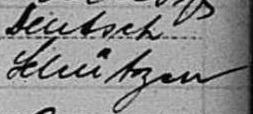 [Ed.
note: after sending this message I looked at page 2 of the manifest; it clearly indicates
Deutsch Schützen (image shown here) as his birth place!] Checking the church records for
Deutsch Schützen revealed a Nandor Schlaffer (Nandor is Hungarian for Ferdinand)
born there in 1895. I've attached that record too (line 23). [Ed.
note: after sending this message I looked at page 2 of the manifest; it clearly indicates
Deutsch Schützen (image shown here) as his birth place!] Checking the church records for
Deutsch Schützen revealed a Nandor Schlaffer (Nandor is Hungarian for Ferdinand)
born there in 1895. I've attached that record too (line 23).

So that wraps up Take Two of Finding That Unknown / Misspelled Village. It was
really all about interpreting badly written records... no great tricks involved, rather
the exercise of lots of experience in dealing with problems like this... it is one of the
reasons the BB exists: to provide the expertise that new researchers just can't be expected to
have. So if you have a stumper, drop us a note!
|
3) FAMILYSEARCH’S RECORD-PRESERVATION STRATEGY
All of us have our own wish-list of records that we would love to have easy access to... but
those lists seldom are in perfect agreement. So how does an organization like FamilySearch
pick and choose which records it will next make available?
Angelyn Hutchinson, a volunteer "features and news" writer for FamilySearch.org,
recently wrote about FamilySearch's strategy for prioritizing and preserving
genealogically-valuable records from around the world. I present my summary of her key points
below (you can find the full article here:
media.familysearch.org/familysearch-strategy...).
FamilySearch has a Global Content Strategy Team that creates its record strategy
by "prioritizing localities and identifying the record collections with the greatest
genealogical value." While specific locations and genealogical value are of greatest
importance, the need to further prioritize records at risk of loss is an additional factor that
can alter this basic content strategy.
 As
you know, FamilySearch now use its resources to preserve what it can digitally.
Volunteers, contractors, employees, and archive staff currently operate up to 330 cameras in
about 50 countries around the world, capturing up to 140 million digital images of historical
records annually. These records are then made accessible in FamilySearch’s online catalog
and its historical record collections. As
you know, FamilySearch now use its resources to preserve what it can digitally.
Volunteers, contractors, employees, and archive staff currently operate up to 330 cameras in
about 50 countries around the world, capturing up to 140 million digital images of historical
records annually. These records are then made accessible in FamilySearch’s online catalog
and its historical record collections.
Choosing What to Preserve
With over 200 countries and principalities in the world, how do you prioritize which at-risk
records to preserve first? That’s the challenge for FamilySearch’s global records
strategy team.
Hutchinson reports that they consider a number of variables to develop FamilySearch’s
constantly-evolving strategy to preserve and create access to the world’s historic genealogical
records:
1) Ancestral homelands that are in high demand (since unused records have little value!).
2) Global growth patterns in Church membership (this is why FamilySearch has already
preserved a lot of European records and why their emphasis is slightly switching to Latin
America).
3) Records with broad population coverage and great genealogical value (for example, censuses).
4) Record types that contain the most genealogical information (such as vital records [births,
marriages, deaths]). FamilySearch seeks a combination of government and church records
from a country to create a wide range of genealogical information that will provide researchers
the greatest opportunity to make family history discoveries.
5) Gap-filling record types, such as immigration records; naturalization papers; probate, land,
tax, schools, military, and pension records; orphan records; prison records; and city
directories).
6) Records at risk of destruction.
Hutchinson spent some paragraphs on this last variable, as it is the one that forces alteration
of the basic strategy. I'll summarize those risks in a short list:
Five Greatest Threats to Historical Records
1. Poor archival storage conditions (mold, mildew, rain, sunlight, and insect infestation).
2. Political instability (archives are often totally destroyed by rioters torching government
buildings).
3. Scheduled destruction (records purposely destroyed by governments to reuse storage space or
respond to privacy laws).
4. Death of oral genealogical informants (for example, African tribal elder who can recite all
descendants of the tribes’ members for generations).
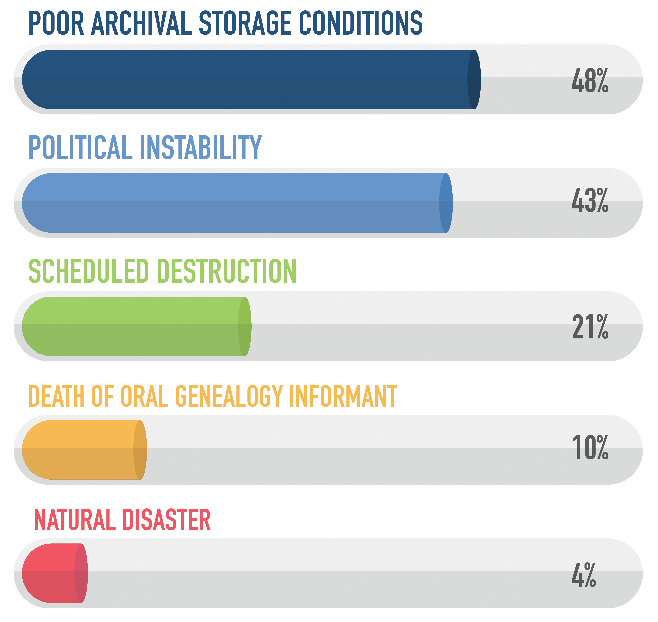
5. Substantial risk of natural disaster (floods, hurricanes, typhoons, fires, and earthquakes).
Some records are, of course, subject to more than one of these threats. Based on the
FamilySearch Team's assessment, the percentage of unpreserved records at risk from
each threat are as shown to the right. Thus we should expect that records at risk from poor
storage conditions and political instability get priority, with the second of these tempered by
the risk to the preservation volunteers.
Based on these goals and threats—plus the necessary cooperation of the record holders,
FamilySearch sets an ever-evolving 15-year plan for using their available physical and
volunteer records-preservation resources. For example, a recent archive agreement with the
Italy National Archives is bringing millions of Italian records to online researchers as
part of the Italian-Ancestors Project.
So, the next time you wonder why those 16th-century Burgenland records are not available online,
perhaps you'll have a better understanding of the considerations involved. Regardless, it does
not hurt to ask... after all, the first variable in the strategy was "ancestral homelands that
are in high demand" ...so make a request!
|
4) MORE DATA FROM THE HISTORISCHES ORTSLEXIKON
[Editorial Note, 2 July 2018: Please note that this article was edited and republished
on this date due to an error in the original version. The first version spoke of "farms"
but this version uses the correct settlement unit, "households." Correcting that error caused
changes in my text, graphics and analysis, so if you already read this article, please re-read
the section concerning the "overall population data." I thank Bernhard Hammer for pointing out
the problem.]

In Newsletter 248, dated October 31, 2014, I first introduced the Historisches
Ortslexikon—Statistische Dokumentation zur Bevölkerungs- und Siedlungsgeschichte—Burgenland.
2011. [ = Historical Place Lexicon—Statistical Documentation of the Population and
Settlement History—Burgenland. 2011.] (see:
248/HistorischesOrtslexikon). I noted then that it was an interesting pdf document
concerning Burgenland produced by the Vienna Institute of Demography of the Austrian
Academy of Sciences and was part of a multipart web publication that documents the
historical settlement history and population counts for the states, counties, districts and
villages of Austria.
That first article gave background on the document, provided a "list of the most important
and/or most common abbreviations and notations" along with translations of them (the
document is written in German... but, as it is mostly numbers, that does not matter a lot), and
then explained some example listing so you could understand the data being made available.
This time, I'm going to look at some of the "overall" Burgenland data that is offered,
that being the overall population data for Burgenland since 1570, and then the "ethnic"
subpopulation data for Croatians, Hungarians, Romany, and Jews. The breakout for ethnic Germans
is calculated by subtraction of these minority ethnicities from the total population; the German
subpopulation data was not provided.

I'll start with the overall population data, listing it below (followed by some
explanation, of course):
BURGENLAND
1570: * 9,600 - 48,000
1575: *10,500
1697: * - 96,000
1720: 12,480
1787: 27,422 - 182,964
1805: - 187,000
1824: - 216,467
1828: - 222,108
1836: - 224,594
1850: - 238,179
1869: 38,852 - 254,301
1880: 41,256 - 270,090
1890: 43,816 - 282,225
1900: 46,375 - 292,426
1910: 47,754 - 292,007
1920: 47,814 - 294,849
1923: 49,305 - 285,698
1934: 55,838 - 299,447
1939: - 287,866
1951: 58,504 - 276,136
1961: 66,617 - 271,001
1971: 76,247 - 272,319
1981: 93,413 - 269,771
1991: 103,529 - 270,880
2001: 114,403 - 277,558
2006:(116,864)- 280,082
2007: - 281,185
2008: - 283,118
2009: - 283,965
2010: - 284,897
6/2011: - 285,255
What you should see above is a double column of data, by year, where the first number is
household counts and the second number is population. I have reformatted this from
the run-together compact form in the Ortslexikon into a linear form and have aligned the
columns for easier reading.
Things to note about this data:
1) the * indicates "fuzzy" data that was estimated in some way (the original notes explain how,
but I'll skip that here) ...I will accept this fuzzy data as presented;
2) the 2006 household data, shown in (), was constructed in some way (but is believed to be
accurate) ...I will accept this data as presented;
3) There are missing data and, as I want to graph this data, I will fill in the missing values
by linear interpolation or linear extrapolation based on the proportional change
in year.
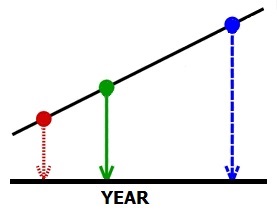 [Note:
Linear interpolation is a method for estimating missing data when you have data on either
side of it. For example, in the diagram to the right, we can estimate a value for the 'green'
year by drawing a straight line between the data points for the 'red'
and 'blue' years and picking off the value from the line at
the 'green' year. Linear extrapolation changes this
slightly: If we wish to estimate a value for the 'blue' year
and we have data for the 'red' and 'green'
years, we draw a straight line between the values for the 'red'
and 'green' years, extend it past the 'blue'
year, then pick off the value from the line at the 'blue'
year. While I described this visually, I actually obtained my estimated values via
mathematically-equivalent equations. As in all data estimation, these methods are not perfect
(and extrapolation is considered less reliable than interpolation), but they will suffice for my
purposes]. [Note:
Linear interpolation is a method for estimating missing data when you have data on either
side of it. For example, in the diagram to the right, we can estimate a value for the 'green'
year by drawing a straight line between the data points for the 'red'
and 'blue' years and picking off the value from the line at
the 'green' year. Linear extrapolation changes this
slightly: If we wish to estimate a value for the 'blue' year
and we have data for the 'red' and 'green'
years, we draw a straight line between the values for the 'red'
and 'green' years, extend it past the 'blue'
year, then pick off the value from the line at the 'blue'
year. While I described this visually, I actually obtained my estimated values via
mathematically-equivalent equations. As in all data estimation, these methods are not perfect
(and extrapolation is considered less reliable than interpolation), but they will suffice for my
purposes].
Here is the data after the missing values are estimated, with linear interpolated data in
bolded green text, and linear extrapolated data in
bolded blue text:
| Year |
Households |
Population |
| 1570 |
9,600 |
48,000 |
| 1575 |
10,500 |
49,890 |
| 1697 |
12,166 |
96,000 |
| 1720 |
12,480 |
118,224 |
| 1787 |
27,422 |
182,964 |
| 1805 |
29,931 |
187,000 |
| 1824 |
32,579 |
216,467 |
| 1828 |
33,137 |
222,108 |
| 1836 |
34,252 |
224,594 |
| 1850 |
36,204 |
238,179 |
| 1869 |
38,852 |
254,301 |
| 1880 |
41,256 |
270,090 |
| 1890 |
43,816 |
282,225 |
| 1900 |
46,375 |
292,426 |
| 1910 |
47,754 |
292,007 |
| 1920 |
47,814 |
294,849 |
| 1923 |
49,305 |
285,698 |
| 1934 |
55,838 |
299,447 |
| 1939 |
56,622 |
287,866 |
| 1951 |
58,504 |
276,136 |
| 1961 |
66,617 |
271,001 |
| 1971 |
76,247 |
272,319 |
| 1981 |
93,413 |
269,771 |
| 1991 |
103,529 |
270,880 |
| 2001 |
114,403 |
277,558 |
| 2006 |
116,864 |
280,082 |
| 2007 |
117,356 |
281,185 |
| 2008 |
117,848 |
283,118 |
| 2009 |
118,341 |
283,965 |
| 2010 |
118,833 |
284,897 |
| 2011 |
119,325 |
285,255 |
As always, masses of data are easier to understand when shown graphically:
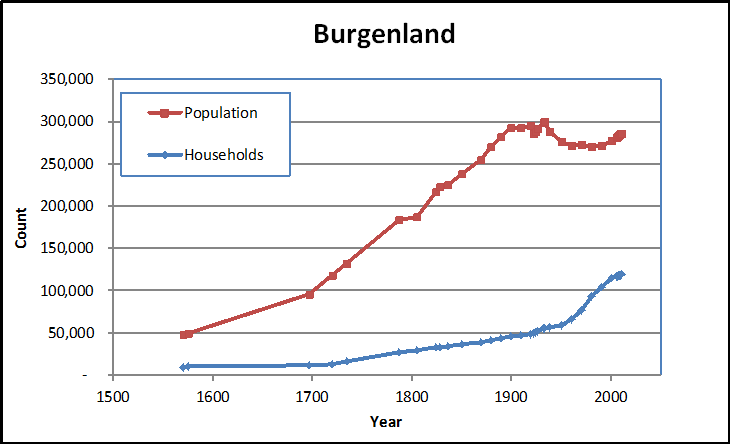
There are a number of notable features about this data.
First, the population of Burgenland rose nearly linearly over time from about
50,000 people in the late 1500s up to nearly 300,000 around 1900. The actual population high
point was 1934, the last recorded point before WW-II. Between 1900 and 1934, the population
remain fairly constant, though there is a noticeable dip for 1923. It would be easy to say that
this was due to WW-I (and I'm sure the war had some effect) but it more likely (or more
directly) was due to the movement of ethnic Hungarians out of Burgenland after the
territory changed countries (it was the first population count after that changeover). During
and after WW-II, the population shrunk slightly and then remain mostly flat, only showing an
increasing trend in the 2000s (almost certainly due to the influx of emigrants attracted
by Burgenland's improving economy).
One expected effect that does not show up is a population reduction
due to the early emigration. Despite about 20,000 Burgenländers emigrating to America in the
1870-1900 period, the population continued to increase apace over those years. However, it seems
evident that the post-1900 emigration, being much larger than the pre-1900 emigration, is at
least partly responsible for the flat population numbers in the 1900-1934 period.
When we look at the number of households, the big surprise was the large increase
in households after 1950. I'll come back to this in a bit, after I comment on the earlier data.
I'll conjecture that there are three mostly "linear" sections to the household data: up to 1720;
from 1720 until 1950, and 1950 and beyond. So why did the rate of increase in households change
between 1720 and 1787 (the two data points surrounding this change), or did it change?
One could easily argue that there was no change in rate—after all, I had just said the
population data rose nearly linearly yet there is an apparently perceptible "elbow" in that data
at 1700 that I ignored! However, my argument for a rate change comes from the following
points:
In the reported years prior to 1720, Burgenland was affected negatively by the Ottoman
incursions toward Vienna and Styria, and the Ottoman presence in nearby Western Hungary made
economic improvement difficult in the Burgenland area. Then, after the Ottomans were driven out,
the peasant Kuruc wars of Rákóczi and others rained additional destruction down on
Burgenland. That peasant unrest resulted, eventually, in the 1767 Urbarium that provided
initial rights to the peasants concerning the land they farmed and opened the doors for more
land movement from the nobility to them. While we have no additional data points between 1720
and 1787, the household count more than doubled during this period, after being essentially flat
between 1700 and 1720. Part of that increase in household count was likely due to the 55%
increase in population during the period. Part of the remainder was likely due to the increased
ability to move away from the farm, given the new freedoms granted by the 1767
Urbarium, and establish a new household. More likely, they increased hand-in-hand due to the
peaceful political environment and the improved legal ability to control both land and personal
destiny.
But let us look again at the post-1950 change in household count. You certainly cannot say it
was in response to a Burgenland population growth, as population fell initially in this period
and remained mostly flat, while household count more than doubled. However, it is known that
this doubling occurred during a well-documented shift to a non-agrarian society in
Burgenland!
People were moving away from the farms, taking industrial jobs instead. Having no need for land
to support themselves, they could establish their own households on just a small lot. Further,
the farmers themselves became more efficient due to mechanization—one man on a tractor
could replace a large family of workers!
If we divide population in each year by number of households in Burgenland for that year, that
ratio falls dramatically starting in 1920. As you can see in the graph below, I have added the
ratio of Burgenland population to household count (Pop/Household) using the axis scale on the
right. The ratio was fairly constant from 1787 until 1920, being between 6.1 and 6.7 people per
household for the full period. After 1920, it fell precipitously to about 2.4 people per
household in 2000, whereafter it appears to be creating a new plateau.
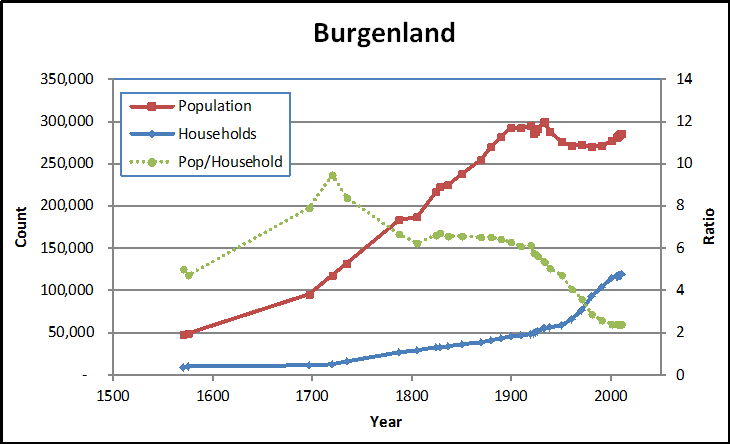
Now this does not mean that there are currently 2.4 farmers per household. A far greater
proportion of Burgenland's population currently works in business, government and other
non-farming occupations than ever did in its agrarian past, so, though the ratio of
population to households in the pre-industrial era was likely closer to the ratio of
farmers to farms, I'll argue that the current ratio of farmers to households is much
lower than this computed 2.4 people per household in Burgenland (as a good portion of
those 2.4 people are not farmers!); how much lower, I don't know.

I'll now move on to the other datasets, which unfortunately are not nearly so
complete. What the Ortslexikon provided was limited data on the number of
Croatian, Hungarian, Roma and Jewish residents, unfortunately for limited and differing
years. What I chose to do was to construct a master data table with rows for every year
appearing in these datasets and in the above total population dataset, terminating at the last
year (1991) reported for an ethnic subset.
To do so, I interpolated between reported values for each ethnic type for each unreported
year, with three exceptions:
- for years prior to the first reported value, I filled in the prior years by maintaining
the same proportion of the ethnic subset to the total population;
- for years after the last reported Roma value, I filled in with that last value; and
- for Jewish, I filled in with a fixed count (12) reported by a number of other sources
for post-1938 Jewish residents in Burgenland.
After filling in all of these unreported values with estimates, I calculated the German
ethnic subset for a year as the difference between the total Burgenland population for that
year and the sum of the other ethnic subsets for the year.
That resulted in the following constructed dataset (where linearly interpolated values
have a bold blue font, and ratioed early values and
filled late values are in a bold green font):
| Year |
German |
Croatian |
Hungarian |
Roma |
Jewish |
| 1570 |
34,168 |
7,298 |
4,311 |
1,019 |
1,205 |
| 1575 |
35,513 |
7,585 |
4,481 |
1,059 |
1,252 |
| 1697 |
68,336 |
14,595 |
8,622 |
2,038 |
2,409 |
| 1720 |
84,156 |
17,974 |
10,618 |
2,509 |
2,967 |
| 1735 |
94,473 |
20,178 |
11,919 |
2,817 |
3,331 |
| 1787 |
128,625 |
27,817 |
16,432 |
5,498 |
4,592 |
| 1805 |
130,656 |
28,430 |
16,794 |
6,427 |
4,693 |
| 1824 |
151,277 |
32,910 |
19,441 |
7,406 |
5,432 |
| 1828 |
155,206 |
33,768 |
19,947 |
7,612 |
5,574 |
| 1836 |
156,616 |
34,146 |
20,171 |
8,025 |
5,636 |
| 1850 |
168,810 |
36,211 |
21,391 |
5,790 |
5,977 |
| 1869 |
183,662 |
38,663 |
22,839 |
2,756 |
6,382 |
| 1880 |
196,992 |
41,063 |
24,257 |
1,000 |
6,778 |
| 1890 |
206,700 |
42,802 |
25,346 |
1,250 |
6,127 |
| 1900 |
214,648 |
44,540 |
26,263 |
1,500 |
5,475 |
| 1910 |
214,320 |
43,638 |
26,225 |
3,000 |
4,824 |
| 1920 |
216,084 |
44,988 |
25,000 |
4,466 |
4,311 |
| 1923 |
219,693 |
42,011 |
14,931 |
4,906 |
4,157 |
| 1925 |
223,086 |
41,736 |
14,115 |
5,199 |
4,062 |
| 1927 |
225,939 |
41,462 |
13,299 |
6,032 |
3,966 |
| 1933 |
235,877 |
40,637 |
10,850 |
7,153 |
3,680 |
| 1934 |
238,366 |
40,500 |
10,442 |
6,507 |
3,632 |
| 1939 |
238,588 |
37,588 |
8,915 |
2,763 |
12 |
| 1951 |
238,869 |
30,599 |
5,251 |
1,405 |
12 |
| 1961 |
234,921 |
28,126 |
7,669 |
273 |
12 |
| 1971 |
241,835 |
24,526 |
5,673 |
273 |
12 |
| 1981 |
246,577 |
18,762 |
4,147 |
273 |
12 |
| 1991 |
244,372 |
19,460 |
6,763 |
273 |
12 |
Again, the easiest way to visualize this data is with a graph:
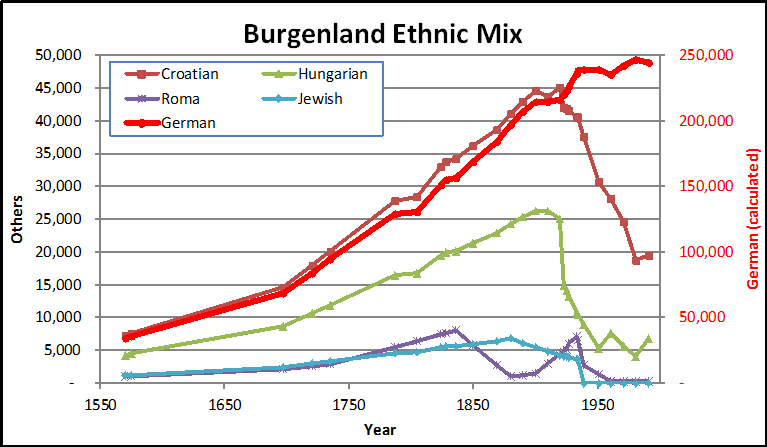
Because the ethnic German population is so much larger that the other ethnic subsets, I have
placed it on its own axis on the right. All other ethnic subsets use the axis scale on the left
(spanning only one-fifth of the range for the German population).
As you can see, the German ethnic population (bold red line)
rises from approximate 34,000 residents to nearly 250,000 residents in a mostly linear fashion
across these years (i.e., from 1570 to 1991). All other ethnic group populations rise similarly
in the early years but then hit a point where their numbers fall. [Realistically, given the
way I constructed much of this data, everything before 1735 is an estimate (only the sum of all
the ethnicities is based on hard data), as is much of it before 1880 (only Roma have "real" data
before 1880). So take that early data with the proverbial "grain of salt." However, the key
things I say below are from more-recent times and are based on real data.]
Not surprisingly, the number of Hungarians (lime-green line)
has its high point in 1910 (its first real data point), which is just prior to WW-I and
Burgenland becoming part of Austria, and then falls steadily after 1920 until 1981.
Interestingly, it shows a rise in the 1991 data point, which is three years after the Iron
Curtain between Austria and Hungary fell.
What was a surprise to me was that the number of Croatians (magenta-purple
line) also fell precipitously after 1920 with the change of Burgenland to Austrian
rule. The Croatian count rose next only in 1961 and roughly plateaued thereafter. Further, I was
not aware that the Croatian population in Burgenland was nearly double that of the
Hungarian population before the change to Austrian rule. That it remained higher after the
changeover is not a surprise.
The number of Jews (light blue line) has its high
point in 1880 (its first real data point), thereafter being on a steady decline until the 1934
data point; the next point, 1939, is after the Nazi expulsion of the Jews from Burgenland; their
numbers never rose thereafter, due both to the death camps and the understandable unwillingness
of survivors to return.
The number of Roma/Gypsy (violet-purple line) reached its
high point in 1836, then fell dramatically until 1880, where it plateaued for 30 years. The
population steadily rises again until 1933, nearly reaching its previous high point. The Roma
are also subjected to the Nazi expulsions and death camps, losing over half of their number
during the war years; but nearly all of the rest leave Burgenland in the post-war years. While
the second, Nazi-driven decrease is well understood, the early decrease after 1836 is less clear
to me. I'll conjecture that the emigration was triggered by the 1848 abolishment of
serfdom, freeing the Roma to move, but driven by the years of forced assimilation
required by the 18th century laws of Maria Theresa and Josef II.

We end here. I will remind you that I was a statistician in my working career,
thus I have an abiding interest in what data can tell us. I hope you enjoyed my light jaunt
through this data and I invite you to write to me if you can enlighten us on why any of these
data changed in the way they did. While I think my conjectures about the changes are
reasonable, I am merely speculating, thus remain open to other opinions and analysis.
|
5) HISTORICAL BB NEWSLETTER ARTICLES
Editor: This is part of our series designed to recycle interesting articles from the
BB Newsletters of 10 years ago. While I had intended to select something from 2008, I
accidentally ended up 15 years back (2003) and choose an article before realizing I was in the
wrong year. After due consideration, I decided to stick with that choice... so, in this article
from June 2003, Gerry Berghold gets into the meaning of the word "Heimat," providing a general
German "take" and then his own definition. All that prompted me to add my own... if motivated,
please send your own definition to me to be published in the next newsletter!

THE BURGENLAND BUNCH NEWS - No. 119B
June 30, 2003
WAS MEINT "HEIMAT"? HOW IS "HEIMAT" DEFINED?
Bob Strauch forwarded the following from The Week in Germany, May 30, 2003
Editors: Margaret Dornfeld, Valerie Belz; Contributing Writer: Tanya Jones
This is a partial extract:
Where the Heart Is? What Heimat Means Today
Germans are known for their attachment to Heimat—a word with broad and deep
connotations commonly translated as "homeland" or "home." Since the 19th
century, Heimat has been invoked to boost everything from nationalist causes to
sentimental movies about life in the high Alps.
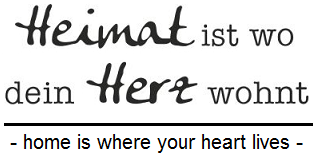 But
what does it really mean to the average German? But
what does it really mean to the average German?
According to a survey recently conducted by the social research institute Emnid for
Reader's Digest Deutschland, 94% of Germans, cutting across all age groups, have a place
or an idea they call Heimat. For 32% of these, it is the place "where I live now,"
while for 14% it is Germany as a whole. Another 13% equate Heimat with family, 12% with
their birthplace, 11% with "a certain region or landscape," another 11% with "where
I feel at ease" and an equal number with the idea of "home in general."
A BB Definition (Gerry)
As a Burgenland writer, I use the term often. To me it means the homeland of my forbears:
my Burgenland grandparents and their ancestors. It also refers to a special place in my own
mind: the place of the origin of my clan, my family, the source of my European family
history.
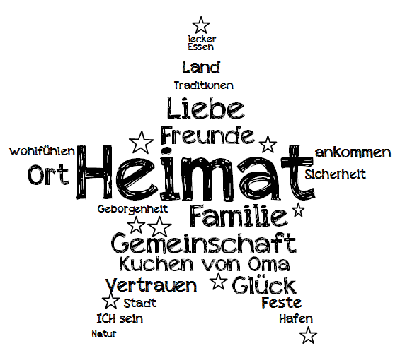
I was born and raised in Allentown, PA—I no longer call it home—I don't think of it as my "Heimat."
I spent time in other places, then 30 years in Delaware and now almost as many in Virginia. I
consider neither my "Heimat." I have relocated too often to have deeply attached roots
anywhere.
A problem with today's American generations—few of us remain in one place long enough to develop
a personal sense of "Heimat." To a Burgenländer, who can look back on many generations of
his family living in one house, one village, however, "Heimat" can only mean his village
or, at most, the general geographic area of his village, his parish, his "Bezirk", his
district. To an immigrant, it had even deeper meaning, it meant the source of his roots—the
place where family still remained—the place for which he forever yearned, remembering the good,
forgetting the bad. Heimat to us, means our ancestral immigrants' Heimat.
My Thoughts (Tom)
I've said it before (I know) but I need to say it again: I'm a Germanic mutt! What I mean
by that is that my ancestral roots are diverse yet derive only from the German-speaking
areas of Europe. Yes, I'm a quarter Burgenländer... but I'm also a quarter
Luxembourger (including the Steichen name)... and the other half of my great-eight comes
from various regions in Germany: Nordrhein-Westfalen (in the northwest of Germany),
Rheinland-Pfalz (west-central Germany), Württemberg (southwest Germany), and Bavaria (southeast
Germany). If I go back one more generation, I also pick up the old German-speaking Oberschlesia
province of Prussia (east Germany), which is now part of Poland. So, while I hold Burgenland
dear, it is hard to call it my only Heimat.
Like Gerry, I've lived most of my adult life away from my birth state (Minnesota, where I
lived for my first 18 years). I "played" in California for two years before being
drafted; spent nearly two years in Germany (compliments of Uncle Sam), went back to
Minnesota for four years of college then on to Kentucky for graduate schooling; then
I lived the biggest chunk of my life in North Carolina, where I worked a 30-year career;
I've been in Pennsylvania now for 6 years (working a 'career' as a grandpa!).
So, are any of those places home or Heimat?
Yes... to me, home is where I live now... so PA, you get that nod (though it
usually takes 2-3 years
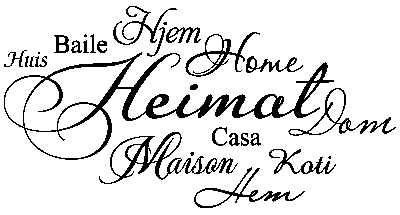 of
settling in before I change my "home" designation). of
settling in before I change my "home" designation).
Heimat? For me, it's Minnesota, where most of my siblings live, where we gather when
we get together, and where my more-recent ancestors are buried, including my mother and father.
It is also where my wife hails from (and her ties there are even stronger than mine, though a
few generations shorter).
Generally speaking, my roots in the US are also two or three generations deeper than many in the
BB; even my Burgenländers were from the beginnings of the early migration, though they were
later arriving than most of my other ancestral immigrants to Minnesota (where all my ancestral
lines intersect). So I have grown deep, concentrated roots there; it's my Heimat... where
is yours?
|
6) ETHNIC EVENTS
LEHIGH VALLEY, PA
Saturday, July 14: 40 Years Lancaster Liederkranz Hobbychor Picnic at the
Lancaster Liederkranz. Info:
www.lancasterliederkranz.com
Sunday, July 15: Jägermeister Day at the Coplay Sängerbund. Music by the Josef
Kroboth Orchestra. Info:
www.coplaysaengerbund.com
Sunday, July 15: Reading Liederkranz Singers' Sommerfest at the Reading
Liederkranz. Music by DJ Ubermeister. Info:
www.readingliederkranz.com
Sunday, July 22: 122nd Anniversary Celebration of the Reading Liederkranz.
Music by Maria & John. Info:
www.readingliederkranz.com
Thursday-Sunday, July 26-29: Parish Festival at Holy Family Roman Catholic
Church in Nazareth. Polka Mass on Saturday. Info:
www.holyfamilynazarethpa.com
NEW BRITAIN, CT
Friday, July 6, 7 pm: Heimat Abend. Austrian Donau Club, 545 Arch Street, $3.
Music by Frank Billowitz.
Friday, July 20, 7:30 pm: Heurigan Abend. Austrian Donau Club, 545 Arch Street,
$3. Music by Schachtelgebirger Musikanten.
TORONTO, CANADA
 Sunday,
July 15, 9 am - 4 pm: Picnic - Anna Kirtag. Burgenländer Club Toronto will hold
their traditional Picnic - Anna Kirtag at Evening Bell Park, Adjala Township, 7th
Concession, Hwy #9 & # 50. Sunday,
July 15, 9 am - 4 pm: Picnic - Anna Kirtag. Burgenländer Club Toronto will hold
their traditional Picnic - Anna Kirtag at Evening Bell Park, Adjala Township, 7th
Concession, Hwy #9 & # 50.
The program includes a Holy Mass, at 10:30 in front of the chapel on the hill, followed by food
service, catered by Vienna Fine Foods. The bar will offer a variety of alcoholic and
non-alcoholic beverages. Music for dancing and listening will be by the Golden Keys. The
swimming pool will be open and games for the young and young at heart are planned.
The picnic will take place rain or shine, since the large clubhouse is available for use.
|
7) BURGENLAND EMIGRANT OBITUARIES
Ernestine Gratzl (née Pree)
 Ernestine
Gratzl, 86, of Parsippany, New Jersey, formerly of Clifton, passed away on May 26, 2018. Ernestine
Gratzl, 86, of Parsippany, New Jersey, formerly of Clifton, passed away on May 26, 2018.
She was the wife of the late Joseph Gratzl, who died in 1996.
Born in Edlitz, Burgenland, Austria, Ernestine came to the U.S. 57 years ago.
She was a factory worker and retired at age 65. She was a parishioner of Holy Trinity Roman
Catholic Church, Passaic.
She is survived by three sons, Josef and his wife, MariAnne Gratzl of Austria; Erwin and his
wife, Renate Gratzl of Glenwood, N.J., and Helmut Gratzl of Pennsylvania. She is also survived
by five grandchildren, Daniel, Christina, Melissa, Rebecca, Anthony, and five
great-grandchildren, Anna, Paula, Sophia, Erika, and William.
Visitation is Friday from 3 to 7 p.m. at JC Fila Lexington Memorial Home, 340 Lexington Ave.,
Clifton, N.J. 07011. The funeral is Saturday at 7:30 a.m. at the funeral home and 8 a.m. Mass is
at Holy Trinity R.C. Church, Passaic, N.J. Entombment is at Calvary Cemetery, Paterson, N.J. In
lieu of flowers, donations in Ernestine's memory may be made to Holy Trinity R.C. Church, 226
Harrison St., Passaic, N.J. 07055.
Published in Star-Ledger on May 31, 2018

Mary Wagner (née Obojkowits)
 Mary
Wagner, 89, wife of the late Julius Wagner, died peacefully at home in Beaufort, South Carolina,
on Thursday, May 31, 2018. Mary
Wagner, 89, wife of the late Julius Wagner, died peacefully at home in Beaufort, South Carolina,
on Thursday, May 31, 2018.
Born September 2, 1928 in Neuhaus in der Wart, Austria, she was a daughter of the late Johann
and Maria (Baldasti) Obojkowits.
She was an Executive Secretary for many years in NY.
She is survived by her son: John Wagner (Brenda); her daughters: Jeanne (Michael) Reistetter,
Rosemarie (Manfred) Wagner-Zochling, and Linda (Dominick) Pesola; and four grandchildren,
Timothy and Kaitlin Reistetter and Christian and Julie Wagner.
Memorial service and burial in NY are planned at a later date. Anderson Funeral Home and
Crematory of Beaufort is serving the family.
Published in The Island Packet on June 6, 2018

Victoria Krizmanich (née Lakovits)
 Victoria
"Vicki" Krizmanich, 97, of South Bend, Indiana passed away on Tuesday, June 5, 2018. Victoria
"Vicki" Krizmanich, 97, of South Bend, Indiana passed away on Tuesday, June 5, 2018.
Born on December 21, 1920 in Nikitsch, Burgenland, Austria, she was a daughter if the late
Albert and Mary Magdeline (Rosenich) Lakovits.
On August 5, 1944, she married Steven Krizmanich, who preceded her in death on June 10, 2002.
Vicki is survived by two sons, Stephen P. Krizmanich of Indianapolis, Indiana and David J.
(Rita) Krizmanich of Fuquay Varina, North Carolina; five grandchildren, Jennifer (Kevin
Calcagno) Krizmanich, Cathy (Scott) Beichley, Laura Krizmanich, Caron (John) Stofleth, and
Michelle (Derek) Walsh; and nine great-grandchildren: Dillon and Adam Calcagno; Ethan, Douglas,
Harrison and Julia Stofleth; Jason and Grace Beichley; and Oisin Walsh.
She was predeceased by her daughter, Celine M. Hamilton; one sister, Mary Kertai; and two
brothers, John and Carl Lakovits.
Vicki was a member of Corpus Christi Catholic Church. She loved to play bingo, attend daily
Mass, Holy Hour, IBEW activities, watching Notre Dame sports, and viewing the ETW Channel.
Visitation for Vicki will be from 2:00 until 6:00 p.m. on Sunday, June 10, 2018 in the Kaniewski
Funeral Home, 3545 N. Bendix Dr., where a Rosary will be prayed at 4:00 p.m. A Mass of Christian
Burial will be celebrated on Monday, June 11, 2018 at 10:00 a.m. in Corpus Christi Catholic
Church, with burial to follow in Highland Cemetery. Memorial contributions may be made to Corpus
Christi Catholic Church, South Bend. Online condolences may be left at www.kaniewski.com.
Published in South Bend Tribune on June 8, 2018

Joseph Neubauer
 Joseph
Neubauer, age 86, of Chicago, Illinois, passed away on Thursday June 7, 2018. Joseph
Neubauer, age 86, of Chicago, Illinois, passed away on Thursday June 7, 2018.
He was the beloved husband of the late Margaret (née Treiber).
Born in Szakonyfalu (Sakalovci/Eckersdorf), Hungary, he came to the U.S. in 1956.
Joseph was a longtime member St. Stephen King of Hungary Church in Chicago.
He was the loving father of Joseph P. (Penny) and Kathy (Dan) Taylor; cherished grandfather of
Joseph (Jacquelyn Podkowa), Wendy (Quentin Lepee), Allison, Danielle and Brandon; fond uncle of
Jozef and Laszlo and dear friend of many and close friend of Erika Mohapp.
Visitation Sunday, June 10th, 2018 from 2:00 until 8:00 p.m. at Cumberland Chapels 8300 W.
Lawrence Ave. Norridge. Funeral Monday, beginning at the funeral home at 9:00 a.m. and will then
proceed to Our Lady Mother of the Church for 10:00 a.m. Mass. Interment will follow at Maryhill
Cemetery in Niles.
Published in a Chicago Tribune Media Group Publication on June 8, 2018

John Jost Jr.
 John Jost
Jr., 88, of New Tripoli Pennsylvania, passed away suddenly from a stroke on June 6, 2018. John Jost
Jr., 88, of New Tripoli Pennsylvania, passed away suddenly from a stroke on June 6, 2018.
He was the husband of Kunigunde (née Dietrich) Jost.
Born in Rábafüzes (Raabfidisch), Burgenland, Austria/Hungary on Nov. 10,1929, he was the son of
the late John and Theresia (née Schmidt) Jost Sr.
He apprenticed as a blacksmith before being displaced, relocating to Bavaria, Germany in 1945.
During his time in Germany, he met his wife, Kunigunde (Kuni - Connie); they would have been
married 65 years in September. After migrating to America, he began his own business, J Jost Jr.
Ornamental Iron Works, which he ran for many years before retiring to his second job... their
small farm. His love of his wife, his children, grandchildren, great-grandchild, and his family
was followed by his love of music, working with his hands, and being outdoors. He was a master
of many things, loved working with his hands, building and fixing anything, and talking with
people.
SURVIVORS: He is survived by his wife, Kunigunde Jost, daughters: Susan Roesch wife of Rick,
Joan Jost, Rosemarie Manley, wife of John (Jack) Manley Sr, grandchildren: Christopher Roesch,
Stephen Roesch, and John (Jack) Manley Jr., and great grandchild, Allison Roesch; brothers,
Rudolph Yost and his wife Marie from Casa Grande, Arizona; Joseph Yost and his wife Suzanne of
Alburtis, Frank Jost and his wife Sallie of Topton, sister Cecilia Vatter of Coplay,
sister-in-law, Lisa Jost (Alfred) of Allentown, along with many nieces and nephews.
He is predeceased by a sister, Irma and brother, Alfred.
SERVICES: A mass of Christian burial will be celebrated on Monday, June 11, 2018 at 11AM. A
viewing will be held from 10AM until the time of service, all at St. Joseph the Worker Catholic
Church 1879 Applewood Drive Orefield, PA 18066. Internment private. CONTRIBUTIONS: In lieu of
flowers, donations may be made in John's name to the Alzheimer's Association P.O. Box 96011
Washington, D.C. 20090-6011 WWW.WEBERFUNERALHOMES.COM.
Published in Morning Call from June 9 to June 10, 2018
|
END OF NEWSLETTER (Even good things must end!)
|
|
NOTICE (Informal Terms and Conditions): The Burgenland Bunch (BB) was formed and
exists to assist Burgenland descendants in their research into their heritage and, toward that
end, reserves the right to use any communication you have with us (email, letter, phone
conversation, data upload, etc.) as part of our information exchange and educational research
efforts.
● If you do not want your communication to be used for this purpose, indicate
that it is "confidential" and we will attempt to abide by that request.
● Correspondents who communicate with the BB without requesting
confidentiality retain their copyright but give a non-exclusive license to the BB allowing
us to forward to BB members, publish in our monthly newsletter or on our website, and/or
subsequently and permanently archive all or parts of such communications.
The formal Burgenland Bunch Website Usage Agreement can be found here:
Agreement
The Burgenland Bunch homepage (website) can be found at:
the-burgenland-bunch.org
Burgenland Bunch Newsletter, copyright © 2018 by The Burgenland
Bunch
All rights reserved. Permission to copy excerpts granted if credit is provided. |
 In
this month's collection of bits and pieces in Article 1 are tidbits
on the negative effects of the new GDPR, on Latin genealogical words, on romance
DNA-style, on spam-fighting overkill, on the latest St. Louis gathering and on a
Burgenland survey, plus a few others.
In
this month's collection of bits and pieces in Article 1 are tidbits
on the negative effects of the new GDPR, on Latin genealogical words, on romance
DNA-style, on spam-fighting overkill, on the latest St. Louis gathering and on a
Burgenland survey, plus a few others.

 As
you know, FamilySearch now use its resources to preserve what it can digitally.
Volunteers, contractors, employees, and archive staff currently operate up to 330 cameras in
about 50 countries around the world, capturing up to 140 million digital images of historical
records annually. These records are then made accessible in FamilySearch’s online catalog
and its historical record collections.
As
you know, FamilySearch now use its resources to preserve what it can digitally.
Volunteers, contractors, employees, and archive staff currently operate up to 330 cameras in
about 50 countries around the world, capturing up to 140 million digital images of historical
records annually. These records are then made accessible in FamilySearch’s online catalog
and its historical record collections.
 [Note:
Linear interpolation is a method for estimating missing data when you have data on either
side of it. For example, in the diagram to the right, we can estimate a value for the 'green'
year by drawing a straight line between the data points for the 'red'
and 'blue' years and picking off the value from the line at
the 'green' year. Linear extrapolation changes this
slightly: If we wish to estimate a value for the 'blue' year
and we have data for the 'red' and 'green'
years, we draw a straight line between the values for the 'red'
and 'green' years, extend it past the 'blue'
year, then pick off the value from the line at the 'blue'
year. While I described this visually, I actually obtained my estimated values via
mathematically-equivalent equations. As in all data estimation, these methods are not perfect
(and extrapolation is considered less reliable than interpolation), but they will suffice for my
purposes].
[Note:
Linear interpolation is a method for estimating missing data when you have data on either
side of it. For example, in the diagram to the right, we can estimate a value for the 'green'
year by drawing a straight line between the data points for the 'red'
and 'blue' years and picking off the value from the line at
the 'green' year. Linear extrapolation changes this
slightly: If we wish to estimate a value for the 'blue' year
and we have data for the 'red' and 'green'
years, we draw a straight line between the values for the 'red'
and 'green' years, extend it past the 'blue'
year, then pick off the value from the line at the 'blue'
year. While I described this visually, I actually obtained my estimated values via
mathematically-equivalent equations. As in all data estimation, these methods are not perfect
(and extrapolation is considered less reliable than interpolation), but they will suffice for my
purposes]. Sunday,
July 15, 9 am - 4 pm: Picnic - Anna Kirtag. Burgenländer Club Toronto will hold
their traditional Picnic - Anna Kirtag at Evening Bell Park, Adjala Township, 7th
Concession, Hwy #9 & # 50.
Sunday,
July 15, 9 am - 4 pm: Picnic - Anna Kirtag. Burgenländer Club Toronto will hold
their traditional Picnic - Anna Kirtag at Evening Bell Park, Adjala Township, 7th
Concession, Hwy #9 & # 50.  Ernestine
Gratzl, 86, of Parsippany, New Jersey, formerly of Clifton, passed away on May 26, 2018.
Ernestine
Gratzl, 86, of Parsippany, New Jersey, formerly of Clifton, passed away on May 26, 2018. Mary
Wagner, 89, wife of the late Julius Wagner, died peacefully at home in Beaufort, South Carolina,
on Thursday, May 31, 2018.
Mary
Wagner, 89, wife of the late Julius Wagner, died peacefully at home in Beaufort, South Carolina,
on Thursday, May 31, 2018. Victoria
"Vicki" Krizmanich, 97, of South Bend, Indiana passed away on Tuesday, June 5, 2018.
Victoria
"Vicki" Krizmanich, 97, of South Bend, Indiana passed away on Tuesday, June 5, 2018. Joseph
Neubauer, age 86, of Chicago, Illinois, passed away on Thursday June 7, 2018.
Joseph
Neubauer, age 86, of Chicago, Illinois, passed away on Thursday June 7, 2018. John Jost
Jr., 88, of New Tripoli Pennsylvania, passed away suddenly from a stroke on June 6, 2018.
John Jost
Jr., 88, of New Tripoli Pennsylvania, passed away suddenly from a stroke on June 6, 2018. News
News Latin
Phrase Dictionary: The Genealogy In Time magazine website has an online
translating dictionary for Latin words and phrases that might appear in wills, parish records or
land records. You can find it here:
Latin
Phrase Dictionary: The Genealogy In Time magazine website has an online
translating dictionary for Latin words and phrases that might appear in wills, parish records or
land records. You can find it here: DNA
Romance: So, can DNA help you find that Mr. or Ms. Perfect?
DNA
Romance: So, can DNA help you find that Mr. or Ms. Perfect? 


 Update
for book "The Burgenländer Emigration to America": Here is this month's update on
purchases of the English issue of the 3rd edition of Dr. Walter Dujmovits' book "Die
Amerika-Wanderung Der Burgenländer."
Update
for book "The Burgenländer Emigration to America": Here is this month's update on
purchases of the English issue of the 3rd edition of Dr. Walter Dujmovits' book "Die
Amerika-Wanderung Der Burgenländer."
 1
apple, cut into small pieces
1
apple, cut into small pieces
 Reminder:
We no longer have a "regular" source for Burgenland recipes. As evidenced above, a few readers
have shared favorite family recipes, and we do have a reserve for a couple of months now, but if
contributions stop coming in, we'll be begging again! So, please consider sharing your favorite
Burgenland recipes or recipe books with us. Our older relatives sadly aren't with us forever, so
don't allow your allow your favorite ethnic dishes to become lost to future generations. Send
your suggestions to BB Recipes Editor,
Reminder:
We no longer have a "regular" source for Burgenland recipes. As evidenced above, a few readers
have shared favorite family recipes, and we do have a reserve for a couple of months now, but if
contributions stop coming in, we'll be begging again! So, please consider sharing your favorite
Burgenland recipes or recipe books with us. Our older relatives sadly aren't with us forever, so
don't allow your allow your favorite ethnic dishes to become lost to future generations. Send
your suggestions to BB Recipes Editor,

 Knowing
that more eyes on a problem are always helpful, I wrote to the BB staff, asking them to look at
this manifest and to make suggestions on the village names, both on my transcriptions of the
writing and their interpretations of what the village names should be.
Knowing
that more eyes on a problem are always helpful, I wrote to the BB staff, asking them to look at
this manifest and to make suggestions on the village names, both on my transcriptions of the
writing and their interpretations of what the village names should be.  Ferdinand
Schlaffer, from "Leinctleva, Hungary" is likely only a little harder, mainly
because of less-definitive starting info. I looked at the manifest and read the village name
as a bit different from what the transcriber recorded... even then you have to do a lot of
"interpreting" of what was written for the home village. I read it as Lemetlevö but
interpreted it as Németlövö (Deutsch Schützen).
Ferdinand
Schlaffer, from "Leinctleva, Hungary" is likely only a little harder, mainly
because of less-definitive starting info. I looked at the manifest and read the village name
as a bit different from what the transcriber recorded... even then you have to do a lot of
"interpreting" of what was written for the home village. I read it as Lemetlevö but
interpreted it as Németlövö (Deutsch Schützen).
 [Ed.
note: after sending this message I looked at page 2 of the manifest; it clearly indicates
Deutsch Schützen (image shown here) as his birth place!] Checking the church records for
Deutsch Schützen revealed a Nandor Schlaffer (Nandor is Hungarian for Ferdinand)
born there in 1895. I've attached that record too (line 23).
[Ed.
note: after sending this message I looked at page 2 of the manifest; it clearly indicates
Deutsch Schützen (image shown here) as his birth place!] Checking the church records for
Deutsch Schützen revealed a Nandor Schlaffer (Nandor is Hungarian for Ferdinand)
born there in 1895. I've attached that record too (line 23).


 But
what does it really mean to the average German?
But
what does it really mean to the average German? 
 of
settling in before I change my "home" designation).
of
settling in before I change my "home" designation).